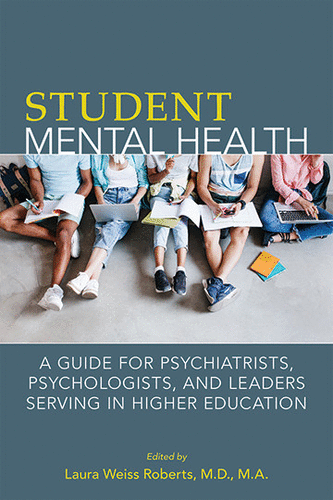Student Mental Health: A Guide for Psychiatrists, Psychologists, and Leaders Serving in Higher Education

Student Mental Health: A Guide for Psychiatrists, Psychologists, and Leaders Serving in Higher Education is a good introductory guide to many of the social and clinical issues encountered by student mental health clinicians. This book is not a comprehensive text, and it does not provide in-depth exploration of some of the more complex, advanced student mental health issues (see below).
Part 1 provides an overview of general topics relevant to student mental health, including discussion of transition-age youths, campus culture, student mental health program structure, and suggestions for self-care for student mental health clinicians. The chapter “Strategies for Excellence in Student Health Programs” may be one of the most useful chapters in this book, and the author clearly has expertise in the subject matter. He poignantly describes the tensions faced as campuses and clinicians strive to provide excellent care while often being perceived as lacking and unresponsive. The chapter “Burnout and Self-Care of Clinicians in Student Mental Health Services” is particularly relevant because student mental health clinicians work with a particularly challenging population—a group of young adults at an age when mental illness often presents; a group at higher risk of suicide; an intelligent, privileged population; and a group with a lot to lose. Unfortunately, this chapter misses the mark and, rather than address these issues, examines the risks of burnout inherent to those who practice medicine in general. The chapter does address the unfortunate, all too common expectations for excellent service in the presence of woeful underfunding and understaffing.
Part 2 provides an overview of developmental, social, academic, and resilience issues among college students. The discussion of Jeffrey Arnett’s description of the period of emerging adulthood is vital foundational knowledge for any student mental health clinician.
Part 3 focuses on clinical evaluation and treatment of specific mental health issues in college students. The chapters are very brief with limited specific treatment recommendations and are almost absent of mention of pharmacological interventions.
“The Suicidal Student” chapter does offer useful behavioral strategies but, likewise, neglects any mention of pharmacological intervention. What is particularly disconcerting is the lack of mention of lithium, which has well-documented properties to reduce suicidal ideation (1) and can be judiciously used in acutely suicidal college students with often rapid and positive effect.
I was excited to see the chapter “Innovation, Technology, and Student Well-Being” but was disappointed there was not a discussion of students’ preferred means of communication, which I have generally found to be e-mail and/or text messaging—an issue that requires an examination of boundaries, ethics, and confidentiality concerns.
The final chapters in Part 4 dedicated to distinct populations are particularly useful and unique, as many other college mental health resources do not specifically address these populations. I was left with a few questions after reading these chapters. In terms of military students, I wonder how the authors would respond to those students who are on military scholarships (e.g., medical students) and are fearful of seeking help for mental health issues owing to a fear they will lose their scholarships and military status if they receive a formal mental illness diagnosis. In the chapter dedicated to graduate students and postdoctoral fellows, the authors note it is difficult to obtain clear estimates of psychiatric disorders among graduate students, and they describe the incidence of disorders and symptoms of students in general. The American College Health Association–National College Health Assessment data do include information specific to graduate students (in addition to separate data for undergraduate students). In the chapter on medical students, fellows, and residents, the authors imply that licensing questions are no longer stigmatizing in terms of questions about mental health issues (p. 475). Regrettably, in 2016, two-thirds of state licensure application and renewal questionnaires asked about history of (not just current) mental health issues, and 40% of physicians reported they would be afraid to seek formal mental health care because of fear of negative impact on licensure (2).
For psychiatry residents considering a career in student mental health, and for new student mental health faculty, the book provides a good first introduction. Those who are managing student mental health services would welcome a forum for discussions of more complex student mental health issues, including:
Treatment structure (walk-in, urgent care, late hours, cancellation fees, treatment guidelines, on-call coverage, etc.);
Student mental health and the law (the interaction between the Family Educational Rights and Privacy Act of 1974, the Health Insurance Portability and Accountability Act of 1996 [when applicable], student-clinician confidentiality, mandatory reporting);
History of, prevention of, and response to school violence;
Helping and supporting students as they fail and are dismissed from college, graduate school, or medical school (managing shame, suicidality, debt, a new life path);
Stigma reduction and increasing help-seeking behavior;
Unique challenges to providing psychotherapy with college students;
The role of the psychiatrist or clinician in screening for and providing recommendations for accommodations for psychiatric and psychological disabilities; and
The complexities of effectively diagnosing attention deficit hyperactivity disorder in those who have been intelligent enough to compensate while maintaining appropriate protocol to prevent misuse and diversion of stimulant medication.
1 : Lithium in the prevention of suicide in mood disorders: updated systematic review and meta-analysis. BMJ 2013; 346:f3646Crossref, Medline, Google Scholar
2 : Medical licensure questions and physician reluctance to seek care for mental health conditions. Mayo Clin Proc 2017; 92:1486–1493Crossref, Medline, Google Scholar



